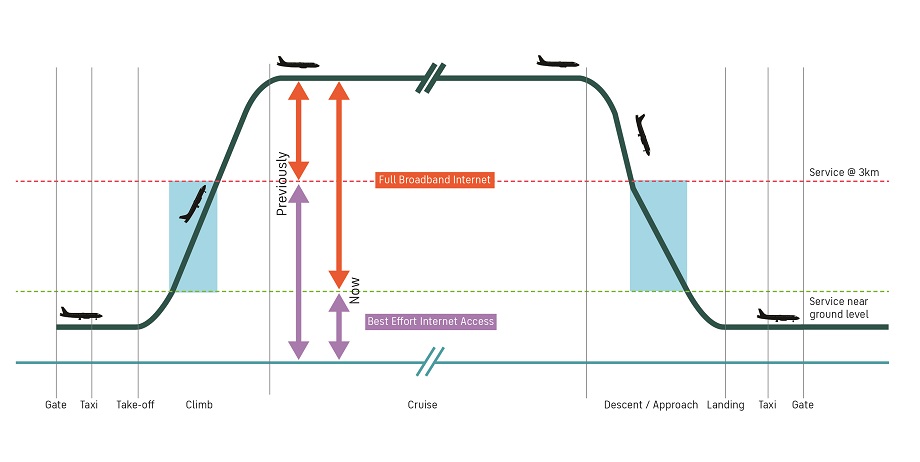IMPROVING EAN’S SERVICE AVAILABILITY
Overall service availability is hugely important for our European Aviation Network (EAN) inflight broadband solution, as it directly impacts the user experience that our airline customers offer their passengers. There are many technical and operational parameters that determine the reliable and consistent availability of EAN.
In our previous Tech Update article, we spoke about how we optimized network performance in the last year, which of course is the backbone to a functioning EAN service. On top of these all-important network tweaks, we want to share two examples of how we directly increased EAN’s service availability for our customers.
EAN also in low altitudes
Until recently, EAN was only offered to passengers at altitudes above 10,000 feet (3 km), which meant the service was not available during the take-off and landing phases of a flight. We have now significantly lowered the boundary of our service delivery by making a number of enhancements to EAN’s onboard Advance Integrated System Manager (AISM). Subject to regulatory restrictions, EAN can now, in some cases, be offered to passengers during climb and approach, getting us very near to ground level.
The decision to activate EAN early in the passenger flight journey currently remains with the airline, as they control most of the specific cabin operations requirements for their aircraft fleet. However, the advantages of earlier inflight connectivity activation are clear. For example, while aircraft usually climb rather fast to reach their cruising altitude of about 8-10 km, their sojourn time in lower altitudes during landing, often due to holding patterns, can contribute to overall flight times. Current studies show that EAN service availability in the new lower altitudes could provide up to nearly 20 minutes of additional online time at some of the busiest European hubs. For pan-European flights with comparably short flight durations of one to three hours, this could add up to about 10-20 % of high speed Internet access time – just enough to enjoy the end of a movie or to send a critical presentation being worked on during the flight prior to landing.
Looking at the data
Learning from and then acting on data collected via our flight monitoring service is another example of how we continuously improve EAN’s service availability. When we launched EAN with our customer Vueling, it became evident that the low altitude portion of the flights approaching or departing from Barcelona could be further improved. We therefore installed another ground station servicing this area in order to significantly improve both coverage and performance of the service provided to aircraft flying near the Catalan capital.

Once again, EAN’s sophisticated service monitoring and reporting capabilities reveal the overall advantage of our integrated system approach. EAN’s overall performance compared to other inflight connectivity solutions stands out in terms of availability, steady throughput and lower latency. It is also very easy to resolve any potential issues and improve our service availability, even after system launch. The flexibility of our solution is key to making EAN future-proof as flight paths change, air traffic increases or the needs of our airline customers evolve.
With all the work done in 2020/21 to improve EAN’s network, it is now stronger than ever and we are prepared for the rest of the year and beyond. We hope to see the global pandemic receding and the airline industry picking up in the second half of this year. We look forward to continue serving our customers with true inflight broadband connectivity as they return to the skies above Europe.
In the final edition of our EAN Tech Update series, we move on from our work in 2020 and discuss what the 5G Evolution means for the European Aviation Network in the years to come.
SOCIAL MEDIA